40. Y: THE LAST MAN
by Brian K. Vaughan, Pia Guerra, Goran Sudzuka, etc., 2002-2008
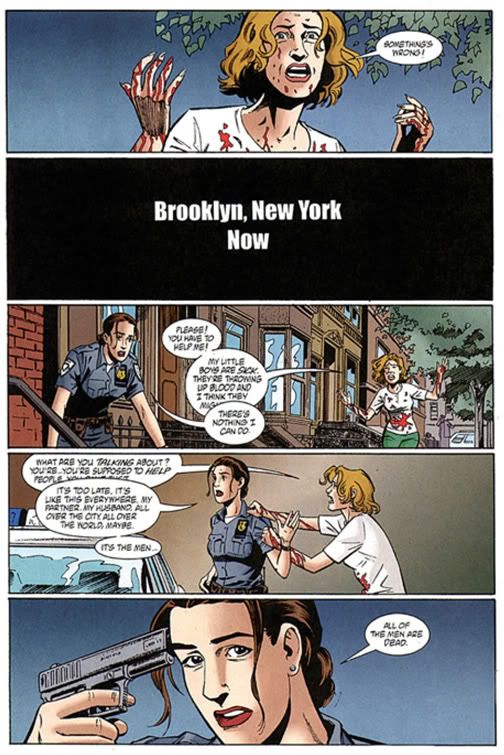 Brian K. Vaughan's Y: The Last Man is pulp storytelling at its best. Starting from a winner of a high-concept premise — a plague wipes out all the males on earth save two, the young slacker Yorick Brown and his misbehaving pet Capuchin monkey — Vaughan explores the various repercussions of this apocalyptic scenario in one exciting, probing story after another. The book wears its politics on its sleeve, and its commentaries on gender, war, race, religion and politics are almost always blunt and on-the-nose. But Vaughan gets it across because he just has such an instinctive feel for genre storytelling, and for characterization over time. Yorick and the increasingly large cast of friends and enemies surrounding him are memorably developed over the series' length. Vaughan's issue-to-issue plotting is impeccable, and the story moves with the page-turning drive of the best pulp fiction. It's almost impossible to put down once you start reading. In this respect, the clean, attractive art of co-creator Pia Guerra (and a string of mostly strong guest artists and substitutes) does just what it should, defining the characters with a few bold strokes and clearly underlining Vaughan's storytelling. There's nothing showy or innovative about this series, just good classical storytelling within a light sci-fi framework. Vaughan earns extra points, too, for his bold final arc, in which he abruptly shifts the series' focus in surprising ways to deliver a strange, emotionally intense, utterly unforgettable coda, the kind of ending that hits like a ton of bricks because no one ever saw it coming and yet, in retrospect, it's an utterly perfect conclusion. [buy] | [buy] | [buy]
Brian K. Vaughan's Y: The Last Man is pulp storytelling at its best. Starting from a winner of a high-concept premise — a plague wipes out all the males on earth save two, the young slacker Yorick Brown and his misbehaving pet Capuchin monkey — Vaughan explores the various repercussions of this apocalyptic scenario in one exciting, probing story after another. The book wears its politics on its sleeve, and its commentaries on gender, war, race, religion and politics are almost always blunt and on-the-nose. But Vaughan gets it across because he just has such an instinctive feel for genre storytelling, and for characterization over time. Yorick and the increasingly large cast of friends and enemies surrounding him are memorably developed over the series' length. Vaughan's issue-to-issue plotting is impeccable, and the story moves with the page-turning drive of the best pulp fiction. It's almost impossible to put down once you start reading. In this respect, the clean, attractive art of co-creator Pia Guerra (and a string of mostly strong guest artists and substitutes) does just what it should, defining the characters with a few bold strokes and clearly underlining Vaughan's storytelling. There's nothing showy or innovative about this series, just good classical storytelling within a light sci-fi framework. Vaughan earns extra points, too, for his bold final arc, in which he abruptly shifts the series' focus in surprising ways to deliver a strange, emotionally intense, utterly unforgettable coda, the kind of ending that hits like a ton of bricks because no one ever saw it coming and yet, in retrospect, it's an utterly perfect conclusion. [buy] | [buy] | [buy]39. SEXY VOICE AND ROBO
by Iou Kuroda, 2000-2003
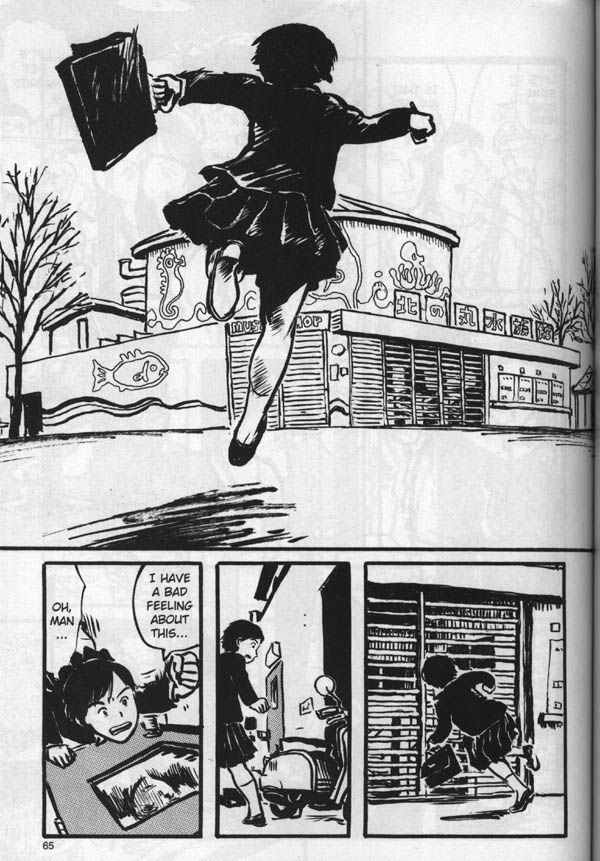 Iou Kuroda is part of that small corner of the Japanese comics industry that is analogous in some way to the American independent or art-comics scenes: working outside of mainstream genres, with a distinctive and decidedly unpolished style, publishing outside of the biggest venues. Sexy Voice and Robo is a collection of Kuroda's short stories starring the titular Sexy Voice, a fourteen-year-old girl who earns her nickname by posing as an older girl for a phone line where guys call in to talk, non-sexually, with what they think are attractive young women. Sexy Voice is preparing herself for a life as a spy, or something equally exciting and glamorous, so she's training herself to act, to be deceitful, and getting herself involved in all sorts of shady business. She becomes an errand girl for an aging mobster, and occasionally ropes in the pathetic toy collector Robo, one of her regular phone line contacts, to serve as an ineffectual bodyguard on her more dangerous outings. Kuroda's stories, however, are less action-packed genre pieces than quiet, reflective examinations of communication, relationships, memory, the gaps between appearance and reality, and the unknowability of the inner self. Throughout it all, Sexy Voice is an endlessly fascinating and charming heroine, overflowing with wit and vivaciousness, caught at a moment halfway between a playful kid and the jaded adult she might someday become. Kuroda's thick linework, so sketchy and so unlike most other manga, is perfectly suited to these unusual, appealing stories, which mix genre elements with an observational affinity for the little things that comprise character. [buy]
Iou Kuroda is part of that small corner of the Japanese comics industry that is analogous in some way to the American independent or art-comics scenes: working outside of mainstream genres, with a distinctive and decidedly unpolished style, publishing outside of the biggest venues. Sexy Voice and Robo is a collection of Kuroda's short stories starring the titular Sexy Voice, a fourteen-year-old girl who earns her nickname by posing as an older girl for a phone line where guys call in to talk, non-sexually, with what they think are attractive young women. Sexy Voice is preparing herself for a life as a spy, or something equally exciting and glamorous, so she's training herself to act, to be deceitful, and getting herself involved in all sorts of shady business. She becomes an errand girl for an aging mobster, and occasionally ropes in the pathetic toy collector Robo, one of her regular phone line contacts, to serve as an ineffectual bodyguard on her more dangerous outings. Kuroda's stories, however, are less action-packed genre pieces than quiet, reflective examinations of communication, relationships, memory, the gaps between appearance and reality, and the unknowability of the inner self. Throughout it all, Sexy Voice is an endlessly fascinating and charming heroine, overflowing with wit and vivaciousness, caught at a moment halfway between a playful kid and the jaded adult she might someday become. Kuroda's thick linework, so sketchy and so unlike most other manga, is perfectly suited to these unusual, appealing stories, which mix genre elements with an observational affinity for the little things that comprise character. [buy]38. LIKEWISE
by Ariel Schrag, 2009
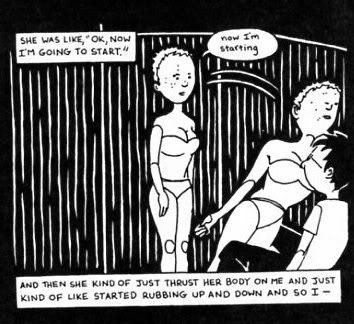 For every year of high school, from 9th grade through 12th grade, Ariel Schrag set herself the task of writing a comic about her experiences. This four-book journey culminates with Likewise, the chronicle of Schrag's 12th grade year, a 300+ page opus that transforms this high-schooler's largely internal dramas into a stylistically diverse stream-of-consciousness epic. The book ranges far and wide, continually shifting from the recounting of events and anecdotes to more conceptual segments where Schrag wrestles with understanding and defining what it means to be a lesbian, or how to get over her long-time crush and one-time girlfriend Sally, or why she documents all this stuff in the first place and what it all means. She frequently namechecks James Joyce's Ulysses, and adapts his stream-of-consciousness style to a high school girl's sense of media overload and diaristic rambling. Schrag's voiceover is a near-constant presence in caption boxes throughout the book, sometimes representing the transcriptions of journal entries, sometimes pages of computer printouts, sometimes tape recordings of conversations and monologues. Her art style is as diverse as her continually morphing prose, too. Her sketchy, expressive figures, with their rubbery faces, sometimes solidify into more densely rendered sequences with delicate shadings, or into pages where rich blacks dominate the compositions, or others where the characters and words seem to be disintegrating into childlike scribbles of great emotional intensity. Throughout it all, Schrag's self-awareness and self-criticism mediate the excesses of her autobiographical indulgence, preventing the book from seeming like the mere teary ramblings of an introspective teenager. By the same token, Likewise is infused with a real sense of humor and observation that pushes Schrag out of herself, forcing her to engage with other people, to include their perspectives in her work to offset her own. It's a dense, rewarding book that transmutes high school melodrama and theatrics into something far richer. [buy]
For every year of high school, from 9th grade through 12th grade, Ariel Schrag set herself the task of writing a comic about her experiences. This four-book journey culminates with Likewise, the chronicle of Schrag's 12th grade year, a 300+ page opus that transforms this high-schooler's largely internal dramas into a stylistically diverse stream-of-consciousness epic. The book ranges far and wide, continually shifting from the recounting of events and anecdotes to more conceptual segments where Schrag wrestles with understanding and defining what it means to be a lesbian, or how to get over her long-time crush and one-time girlfriend Sally, or why she documents all this stuff in the first place and what it all means. She frequently namechecks James Joyce's Ulysses, and adapts his stream-of-consciousness style to a high school girl's sense of media overload and diaristic rambling. Schrag's voiceover is a near-constant presence in caption boxes throughout the book, sometimes representing the transcriptions of journal entries, sometimes pages of computer printouts, sometimes tape recordings of conversations and monologues. Her art style is as diverse as her continually morphing prose, too. Her sketchy, expressive figures, with their rubbery faces, sometimes solidify into more densely rendered sequences with delicate shadings, or into pages where rich blacks dominate the compositions, or others where the characters and words seem to be disintegrating into childlike scribbles of great emotional intensity. Throughout it all, Schrag's self-awareness and self-criticism mediate the excesses of her autobiographical indulgence, preventing the book from seeming like the mere teary ramblings of an introspective teenager. By the same token, Likewise is infused with a real sense of humor and observation that pushes Schrag out of herself, forcing her to engage with other people, to include their perspectives in her work to offset her own. It's a dense, rewarding book that transmutes high school melodrama and theatrics into something far richer. [buy]37. LOST GIRLS
by Alan Moore & Melinda Gebbie, 2006
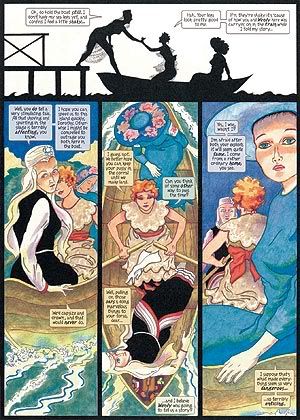 This infamous book is Alan Moore's foray into literary pornography, as he retells the stories of popular fantasy figures Dorothy, Wendy and Alice as sexual adventures, recounted through the lens of nostalgia on the eve of World War II. Melinda Gebbie's sumptuous, quirky artwork lends depth and nuance to Moore's deliberately purplish prose, while the book's themes are much deeper than one would expect from Moore's stubborn insistence that he was making straight-up porn. The book deals with differentiating reality from fantasy, and encouraging imagination as a creative outlet, an escape and a counter to the horrors of reality. It is, in fact, a slap in the face to those who would censor artistic expression. Moore issues challenge after challenge to the puritanical and perverted minds who insist that to look at, or draw, a morally objectionable act is the same as actually engaging in it. It's a beautiful, provocative work. [buy]
This infamous book is Alan Moore's foray into literary pornography, as he retells the stories of popular fantasy figures Dorothy, Wendy and Alice as sexual adventures, recounted through the lens of nostalgia on the eve of World War II. Melinda Gebbie's sumptuous, quirky artwork lends depth and nuance to Moore's deliberately purplish prose, while the book's themes are much deeper than one would expect from Moore's stubborn insistence that he was making straight-up porn. The book deals with differentiating reality from fantasy, and encouraging imagination as a creative outlet, an escape and a counter to the horrors of reality. It is, in fact, a slap in the face to those who would censor artistic expression. Moore issues challenge after challenge to the puritanical and perverted minds who insist that to look at, or draw, a morally objectionable act is the same as actually engaging in it. It's a beautiful, provocative work. [buy]36. BLACK HOLE
by Charles Burns, 1993-2004
 Charles Burns' long-running series Black Hole is the peak of the artist's great career in horror comics. Burns has a knack for locating pathos and unsettling emotions in horror scenarios, and this story about a sexually transmitted plague among small-town teenagers is no exception. The series ran throughout much of the 90s, but since Burns finally published the last few installments and the collected book after the turn of the millennium, presenting it in its long-awaited definitive form, it seems appropriate to count it among the best books of the 2000s. Burns' noirish style is well-suited to this unsettling story, in which teenage anxiety about sexuality is externalized in the form of various mutations that turn affected teens into monstrous creatures, their sexual anguish etched into their bodies as scales, boils, rashes and new appendages. Few books do a better job of capturing the fear, and the excitement, of nascent desire and adolescent longing, as these diseased teens are driven mad by hormones and embarrassment. [buy]
Charles Burns' long-running series Black Hole is the peak of the artist's great career in horror comics. Burns has a knack for locating pathos and unsettling emotions in horror scenarios, and this story about a sexually transmitted plague among small-town teenagers is no exception. The series ran throughout much of the 90s, but since Burns finally published the last few installments and the collected book after the turn of the millennium, presenting it in its long-awaited definitive form, it seems appropriate to count it among the best books of the 2000s. Burns' noirish style is well-suited to this unsettling story, in which teenage anxiety about sexuality is externalized in the form of various mutations that turn affected teens into monstrous creatures, their sexual anguish etched into their bodies as scales, boils, rashes and new appendages. Few books do a better job of capturing the fear, and the excitement, of nascent desire and adolescent longing, as these diseased teens are driven mad by hormones and embarrassment. [buy]35. ALIAS
by Brian Michael Bendis & Michael Gaydos, 2001-2005
 Before Brian Bendis began turning his attention to various Marvel superhero titles, with increasingly diminishing returns, he crafted the masterful series Alias, which existed on the periphery of the Marvel universe and dealt with superhero storytelling in an unusual and emotional way. The series centers on Jessica Jones, who is at least technically a superhero, or was at one time anyway: she has some minor powers, a bit of super strength, and once dressed up as a crimefighter. Now, however, she's settled into a more prosaic life as a private detective, where her powers occasionally come in handy, but mostly she's just a normal, if tough and isolated, woman. What sets this book apart — beyond its presence in Marvel's MAX imprint, which allowed it greater leeway in cursing and sexuality — is its focus on character development over action. Jessica is a strong, complicated character, and the throughline of her growth throughout this book is the real focus rather than the genre plots. Bendis' most brilliant ploy is to use superhero melodramatics as a way of probing character in unexpected ways: Jessica's long-ago encounter with the Purple Man becomes a central device in a surprisingly candid, sophisticated story arc about dealing with sexual abuse and humiliation, while her romantic relationships with superheroes Ant Man and Luke Cage are developed far beyond the usual level of so-called love in superhero comics. The book deals intelligently with issues of trust, insecurity and painful memories, and Jessica is surely one of the most memorable and original female characters in all of superhero comics. [buy] | [buy]
Before Brian Bendis began turning his attention to various Marvel superhero titles, with increasingly diminishing returns, he crafted the masterful series Alias, which existed on the periphery of the Marvel universe and dealt with superhero storytelling in an unusual and emotional way. The series centers on Jessica Jones, who is at least technically a superhero, or was at one time anyway: she has some minor powers, a bit of super strength, and once dressed up as a crimefighter. Now, however, she's settled into a more prosaic life as a private detective, where her powers occasionally come in handy, but mostly she's just a normal, if tough and isolated, woman. What sets this book apart — beyond its presence in Marvel's MAX imprint, which allowed it greater leeway in cursing and sexuality — is its focus on character development over action. Jessica is a strong, complicated character, and the throughline of her growth throughout this book is the real focus rather than the genre plots. Bendis' most brilliant ploy is to use superhero melodramatics as a way of probing character in unexpected ways: Jessica's long-ago encounter with the Purple Man becomes a central device in a surprisingly candid, sophisticated story arc about dealing with sexual abuse and humiliation, while her romantic relationships with superheroes Ant Man and Luke Cage are developed far beyond the usual level of so-called love in superhero comics. The book deals intelligently with issues of trust, insecurity and painful memories, and Jessica is surely one of the most memorable and original female characters in all of superhero comics. [buy] | [buy]34. PLUTO
by Naoki Urasawa, 2003-2009
 Naoki Urasawa's Pluto is the manga-ka's response to his biggest influence, Osamu Tezuka, the single artist who has arguably had the greatest effect on modern Japanese comics. Urasawa takes as his reference point a popular story from Tezuka's long-running Astro Boy series, a sci-fi adventure mostly aimed at younger readers and probably the artist's most famous creation. "The Greatest Robot on Earth" details Astro Boy's struggle against a mysterious and powerful robot called Pluto, who's destroying all of the most powerful robots in the world in a quest to be the best. Urasawa expands upon this story, using Tezuka's original creation as a framework within which he builds his own much more complicated world, filling in details and fleshing out the characters with motivations and histories that were barely even hinted at in Tezuka's breezy, action-oriented tale. Pluto shifts the focus onto robot detective Gesicht, who's investigating a series of murders that may be connected to the systematic destruction of the world's most powerful robots. Urasawa weaves in references to contemporary events, including some surprisingly blunt "war on terror" satire and minimally camouflaged references to Iraq, but his real innovation here lies in the way he digs beneath the surfaces of these characters, unearthing emotions and philosophical questions that cut to the core of what it means to be human, to think and feel and regret and love and hate. Even more than Urasawa's long-running thriller Monster, the real thrust of this much more compact series is an interrogation of the concepts of nature versus nurture, examining the events and experiences that define a person's personality and moral character. Urasawa is always interested in evil, which he sets up as a terrifying absolute only to probe the more subtle gradations between good and evil: in Urasawa's work, everyone has their reasons for what they do, everyone has their secret traumas and tormented memories. It's a pulpy soap opera convention that Urasawa routinely imbues with much greater depth, lending pathos and philosophical sharpness to his propulsive storytelling. [buy] | [buy] | [buy]
Naoki Urasawa's Pluto is the manga-ka's response to his biggest influence, Osamu Tezuka, the single artist who has arguably had the greatest effect on modern Japanese comics. Urasawa takes as his reference point a popular story from Tezuka's long-running Astro Boy series, a sci-fi adventure mostly aimed at younger readers and probably the artist's most famous creation. "The Greatest Robot on Earth" details Astro Boy's struggle against a mysterious and powerful robot called Pluto, who's destroying all of the most powerful robots in the world in a quest to be the best. Urasawa expands upon this story, using Tezuka's original creation as a framework within which he builds his own much more complicated world, filling in details and fleshing out the characters with motivations and histories that were barely even hinted at in Tezuka's breezy, action-oriented tale. Pluto shifts the focus onto robot detective Gesicht, who's investigating a series of murders that may be connected to the systematic destruction of the world's most powerful robots. Urasawa weaves in references to contemporary events, including some surprisingly blunt "war on terror" satire and minimally camouflaged references to Iraq, but his real innovation here lies in the way he digs beneath the surfaces of these characters, unearthing emotions and philosophical questions that cut to the core of what it means to be human, to think and feel and regret and love and hate. Even more than Urasawa's long-running thriller Monster, the real thrust of this much more compact series is an interrogation of the concepts of nature versus nurture, examining the events and experiences that define a person's personality and moral character. Urasawa is always interested in evil, which he sets up as a terrifying absolute only to probe the more subtle gradations between good and evil: in Urasawa's work, everyone has their reasons for what they do, everyone has their secret traumas and tormented memories. It's a pulpy soap opera convention that Urasawa routinely imbues with much greater depth, lending pathos and philosophical sharpness to his propulsive storytelling. [buy] | [buy] | [buy]33. LOUIS RIEL
by Chester Brown, 1999-2003
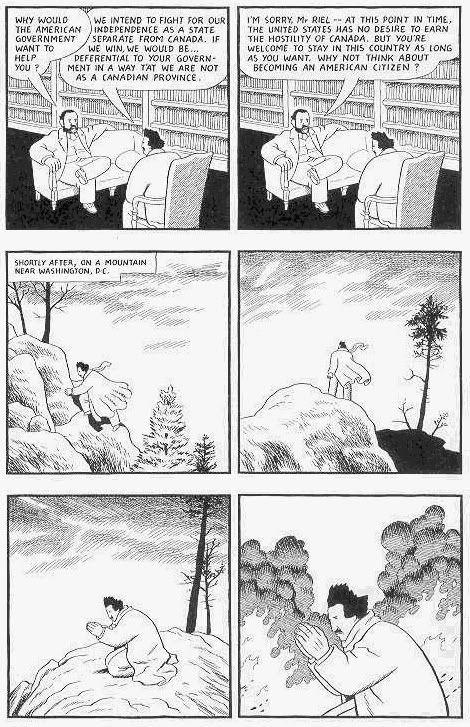 Chester Brown's biography of Canadian dissident Louis Riel is a strange and inscrutable work, presenting Riel's tragic story in a simple, direct style, with little trace of commentary, so that it's difficult to know what to make of this tale: is it a satire, a tragedy, a black comedy, an exploration of spirituality? Or none of the above? Is it simply the story of a life, told in such a way that all the external interpretations, the guesses and conjectures and the weight of history, simply fade into inconsequentiality in the face of Brown's blank-eyed, Harold Gray-inspired style? Riel, for Brown, is simply a man, and when confronted with the unknowability and distance of such an extraordinary but obscure man, Brown sticks to the facts without venturing into more ephemeral areas. The result is an attempt at an "objective" biography that raises many more questions than it even attempts to answer; Brown tried the same thing with Jesus in his Gospel interpretations, with even more confusing and provocative results. [buy]
Chester Brown's biography of Canadian dissident Louis Riel is a strange and inscrutable work, presenting Riel's tragic story in a simple, direct style, with little trace of commentary, so that it's difficult to know what to make of this tale: is it a satire, a tragedy, a black comedy, an exploration of spirituality? Or none of the above? Is it simply the story of a life, told in such a way that all the external interpretations, the guesses and conjectures and the weight of history, simply fade into inconsequentiality in the face of Brown's blank-eyed, Harold Gray-inspired style? Riel, for Brown, is simply a man, and when confronted with the unknowability and distance of such an extraordinary but obscure man, Brown sticks to the facts without venturing into more ephemeral areas. The result is an attempt at an "objective" biography that raises many more questions than it even attempts to answer; Brown tried the same thing with Jesus in his Gospel interpretations, with even more confusing and provocative results. [buy]32. A DRIFTING LIFE
by Yoshihiro Tatsumi, 2009
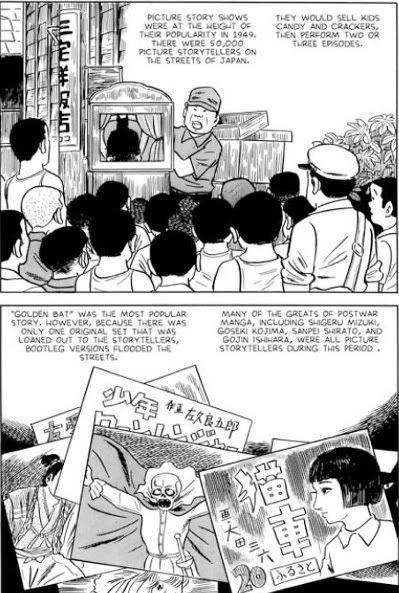 The quiet, introspective manga of Yoshihiro Tatsumi was introduced to American audiences by Drawn & Quarterly's series of hardcover tomes collecting some highlights from Tatsumi's punchy, minimalist short stories. With his simple, direct style and schlumpy everyman protagonists, Tatsumi depicted urban malaise, loneliness and sexual perversion with a flat, affectless tone that contrasted against the sometimes harrowing content of his stories. But as good as these stories are, his magnum opus is a newly produced, massive volume that tells the story of his early years as a struggling manga artist, trying to create a new, more realistic movement within Japan along with a few likeminded artists. It is a memoir of a largely unexplored area of Japanese comics, packed with references to artists and works that are largely unfamiliar in the US. His straightforward style positions this volume as a historical account, establishing the context of this time and place both in relation to Japanese history (World War II, the American occupation, the bombs) and the artist's personal life. It is, typically, concerned with sexual maturity, and also with the internal struggles of a man trying to find his own place in life and art. It is especially enlightening to see Tatsumi himself, through his thinly veiled autobiographical stand-in, assume the place of his usual everyman protagonist, confirming the artist's sense of identification with his troubled, conflicted male antiheroes. [buy]
The quiet, introspective manga of Yoshihiro Tatsumi was introduced to American audiences by Drawn & Quarterly's series of hardcover tomes collecting some highlights from Tatsumi's punchy, minimalist short stories. With his simple, direct style and schlumpy everyman protagonists, Tatsumi depicted urban malaise, loneliness and sexual perversion with a flat, affectless tone that contrasted against the sometimes harrowing content of his stories. But as good as these stories are, his magnum opus is a newly produced, massive volume that tells the story of his early years as a struggling manga artist, trying to create a new, more realistic movement within Japan along with a few likeminded artists. It is a memoir of a largely unexplored area of Japanese comics, packed with references to artists and works that are largely unfamiliar in the US. His straightforward style positions this volume as a historical account, establishing the context of this time and place both in relation to Japanese history (World War II, the American occupation, the bombs) and the artist's personal life. It is, typically, concerned with sexual maturity, and also with the internal struggles of a man trying to find his own place in life and art. It is especially enlightening to see Tatsumi himself, through his thinly veiled autobiographical stand-in, assume the place of his usual everyman protagonist, confirming the artist's sense of identification with his troubled, conflicted male antiheroes. [buy]31. MADMAN ATOMIC COMICS
by Mike Allred, 2007-2009
 Mike Allred's periodic returns to his defining creation are always cause for celebration. Frank Einstein, the reincarnated hitman known as the Madman of Snap City, had previously been the star of three different series, but the last one, Madman Comics, ended in 2000, and Frank's guest spots in Allred's enjoyably fluffy spinoff The Atomics weren't quite as satisfying. Madman Atomic Comics reunites Allred with his signature character, who looks like a superhero but more often acts like a goofy, lovestruck kid, or maybe a philosopher. Indeed, this fusion of childlike enthusiasm and philosophical speculation is the core of Madman, which recycles 60s comics and pop culture tropes without the irony and deconstruction that so often accompanies modern attempts to reinvigorate the culture and kitsch of the not-so-distant past. Allred's characters speak in a hip patois of beatnik lingo, "groovy" 60s hippie-speak and slangy comic patter. His clean, pop-art drawing style reflects a similar blend of eras and influences, a blend that at times explodes to the surface within the pages of this latest series, which perhaps represents the peak of Allred's Madman saga thus far. The series opens with Frank in unfamiliar territory, briefly becoming convinced of his own godlike status before heading off on a twisty odyssey that mostly involves coming to terms with his own past, identity and existence as a creative product. In the series' epic third issue, Allred sends Frank careening through a shifting mental landscape where each individual panel is drawn in a different style from the history of comics. Thus, Allred gets to have great fun envisioning Frank (and his robot doppelganger Astroman) as drawn by a who's who of comics' greatest stylists: Caniff, Crumb, Herrimann, Schultz, Segar, Gottfredson, King, Seuss, even encompassing more obscure indie names like Richard Sala and Chester Brown, alongside various superhero and EC Comics pastiches. It's a dense, fun issue, propelled as much by the constant stream of inquisitive, philosophical dialogue (all about the self and the nature of life) as by the stylistic diversity on display. This is the apex of Allred's latest take on his creation, perhaps, but it's also indicative of the strengths of this series as a whole, its careful balance between dazzling visual ingenuity and the more subtle emotional and intellectual concerns that occupy the minds of Frank and his creator alike. [buy]
Mike Allred's periodic returns to his defining creation are always cause for celebration. Frank Einstein, the reincarnated hitman known as the Madman of Snap City, had previously been the star of three different series, but the last one, Madman Comics, ended in 2000, and Frank's guest spots in Allred's enjoyably fluffy spinoff The Atomics weren't quite as satisfying. Madman Atomic Comics reunites Allred with his signature character, who looks like a superhero but more often acts like a goofy, lovestruck kid, or maybe a philosopher. Indeed, this fusion of childlike enthusiasm and philosophical speculation is the core of Madman, which recycles 60s comics and pop culture tropes without the irony and deconstruction that so often accompanies modern attempts to reinvigorate the culture and kitsch of the not-so-distant past. Allred's characters speak in a hip patois of beatnik lingo, "groovy" 60s hippie-speak and slangy comic patter. His clean, pop-art drawing style reflects a similar blend of eras and influences, a blend that at times explodes to the surface within the pages of this latest series, which perhaps represents the peak of Allred's Madman saga thus far. The series opens with Frank in unfamiliar territory, briefly becoming convinced of his own godlike status before heading off on a twisty odyssey that mostly involves coming to terms with his own past, identity and existence as a creative product. In the series' epic third issue, Allred sends Frank careening through a shifting mental landscape where each individual panel is drawn in a different style from the history of comics. Thus, Allred gets to have great fun envisioning Frank (and his robot doppelganger Astroman) as drawn by a who's who of comics' greatest stylists: Caniff, Crumb, Herrimann, Schultz, Segar, Gottfredson, King, Seuss, even encompassing more obscure indie names like Richard Sala and Chester Brown, alongside various superhero and EC Comics pastiches. It's a dense, fun issue, propelled as much by the constant stream of inquisitive, philosophical dialogue (all about the self and the nature of life) as by the stylistic diversity on display. This is the apex of Allred's latest take on his creation, perhaps, but it's also indicative of the strengths of this series as a whole, its careful balance between dazzling visual ingenuity and the more subtle emotional and intellectual concerns that occupy the minds of Frank and his creator alike. [buy]30. EPILEPTIC/BABEL
by David B., 1996-2003/2004-2006
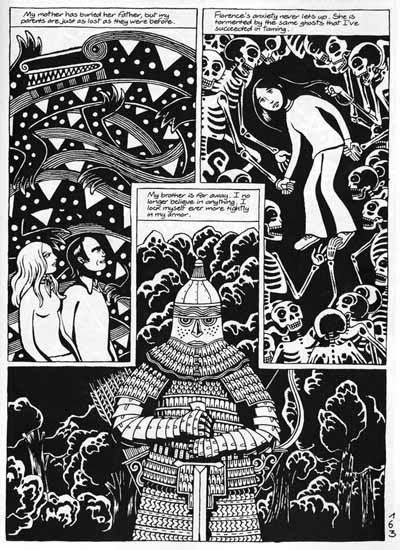 The French cartoonist David B. wrote and published much of his epochal series Epileptic — an autobiographical story about his relationship with his increasingly non-functioning epileptic brother — during the 1990s, but he finished the work and published it in English for the first time during the 2000s, which in some way qualifies it for this list. It is, in any case, an immensely satisfying work, because it doesn't make the mistake of so many autobiographical comics of thinking that a true story is enough. Instead, David B. takes his youth and his brother's ailment as the raw material for his wide-ranging attempts to understand the concepts of sickness, family, history and maturity. With his elegant style, dominated by striking blacks and contrasts, he invents numerous metaphors and visualizations for his brother's disease, treating the fight against the disease as a physical, mortal conflict.
The French cartoonist David B. wrote and published much of his epochal series Epileptic — an autobiographical story about his relationship with his increasingly non-functioning epileptic brother — during the 1990s, but he finished the work and published it in English for the first time during the 2000s, which in some way qualifies it for this list. It is, in any case, an immensely satisfying work, because it doesn't make the mistake of so many autobiographical comics of thinking that a true story is enough. Instead, David B. takes his youth and his brother's ailment as the raw material for his wide-ranging attempts to understand the concepts of sickness, family, history and maturity. With his elegant style, dominated by striking blacks and contrasts, he invents numerous metaphors and visualizations for his brother's disease, treating the fight against the disease as a physical, mortal conflict.David B. then continued his work in Babel, a thus-far incomplete series that elaborates upon the territory of Epileptic by venturing further into political, historical and philosophical content in the context of his family and his youth. This series' examination of genocides and wars brings a global, historically engaged perspective to the artist's affecting visuals. [buy] | [buy]
29. CHIMERA #1
by Lorenzo Mattotti, 2006
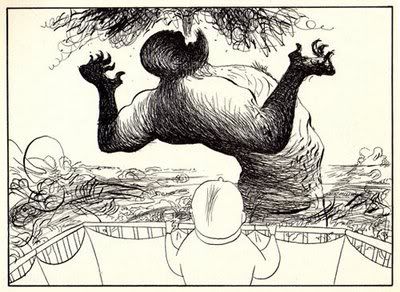 Italian artist Lorenzo Mattotti has not been a particularly prolific presence in comics, though his short albums of the 80s — Fires, Murmur, Labyrinthes — established him as a fine, expressive artist with an intuitive grasp of color. Chimera is thus a rare pleasure from this elusive artist. Drawn for Fantagraphics' Ignatz line and intended to be the first issue of a continuing series — which, true to form, now seems unlikely to materialize — Mattotti's Chimera is a semi-abstract, mostly wordless comic in which multiple styles collide against one another. The book ranges from sketchy, scruffy pen drawings to thick ink washes to passages of dense, frenzied linework. Mattotti captures the flow of dreams and nightmares, fluidly transitioning between layers of reality as his chameleonic style shifts from spacious compositions dominated by white space to dark passages where you have to squint into the inky complexity to suss out the nuances at work within Mattotti's roiling chaos. The book ends with its best sequence, a panel-by-panel journey into a dark, shady forest that hints at a next issue that never was. It would've been great if this series had led somewhere further, but as it is this comic stands alone as a powerful work in itself. [buy]
Italian artist Lorenzo Mattotti has not been a particularly prolific presence in comics, though his short albums of the 80s — Fires, Murmur, Labyrinthes — established him as a fine, expressive artist with an intuitive grasp of color. Chimera is thus a rare pleasure from this elusive artist. Drawn for Fantagraphics' Ignatz line and intended to be the first issue of a continuing series — which, true to form, now seems unlikely to materialize — Mattotti's Chimera is a semi-abstract, mostly wordless comic in which multiple styles collide against one another. The book ranges from sketchy, scruffy pen drawings to thick ink washes to passages of dense, frenzied linework. Mattotti captures the flow of dreams and nightmares, fluidly transitioning between layers of reality as his chameleonic style shifts from spacious compositions dominated by white space to dark passages where you have to squint into the inky complexity to suss out the nuances at work within Mattotti's roiling chaos. The book ends with its best sequence, a panel-by-panel journey into a dark, shady forest that hints at a next issue that never was. It would've been great if this series had led somewhere further, but as it is this comic stands alone as a powerful work in itself. [buy]28. DOGS AND WATER
by Anders Nilsen, 2004
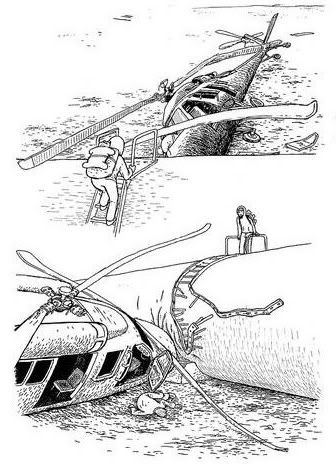 Dogs and Water is the most complete and potent statement thus far from promising young cartoonist Anders Nilsen, who has created a small but intriguing body of work ranging from his in-progress series Big Questions, to his harrowing attempts to respond to the death of his fiancée in The End and Don't Go Where I Can't Follow, to his two books of ultra-minimal sketchbook exercises, to his various anthology appearances and short-form experiments. In Dogs and Water, his talent is at its most concentrated and distilled, creating a simple but enduring work whose resonances and themes lie just beneath the placid surface. With his minimal line and judicious use of white space, Nilsen sketches out a forlorn wasteland where a solitary wanderer drifts along, encountering various horrors along the way. The book is a parable of wartime dislocation and dehumanization, a mostly wordless story where communication is difficult but ultimately offers the only hope of salvation for these disconnected, isolated people. [buy]
Dogs and Water is the most complete and potent statement thus far from promising young cartoonist Anders Nilsen, who has created a small but intriguing body of work ranging from his in-progress series Big Questions, to his harrowing attempts to respond to the death of his fiancée in The End and Don't Go Where I Can't Follow, to his two books of ultra-minimal sketchbook exercises, to his various anthology appearances and short-form experiments. In Dogs and Water, his talent is at its most concentrated and distilled, creating a simple but enduring work whose resonances and themes lie just beneath the placid surface. With his minimal line and judicious use of white space, Nilsen sketches out a forlorn wasteland where a solitary wanderer drifts along, encountering various horrors along the way. The book is a parable of wartime dislocation and dehumanization, a mostly wordless story where communication is difficult but ultimately offers the only hope of salvation for these disconnected, isolated people. [buy]27. THE DARK KNIGHT STRIKES AGAIN
by Frank Miller & Lynn Varley, 2001-2002
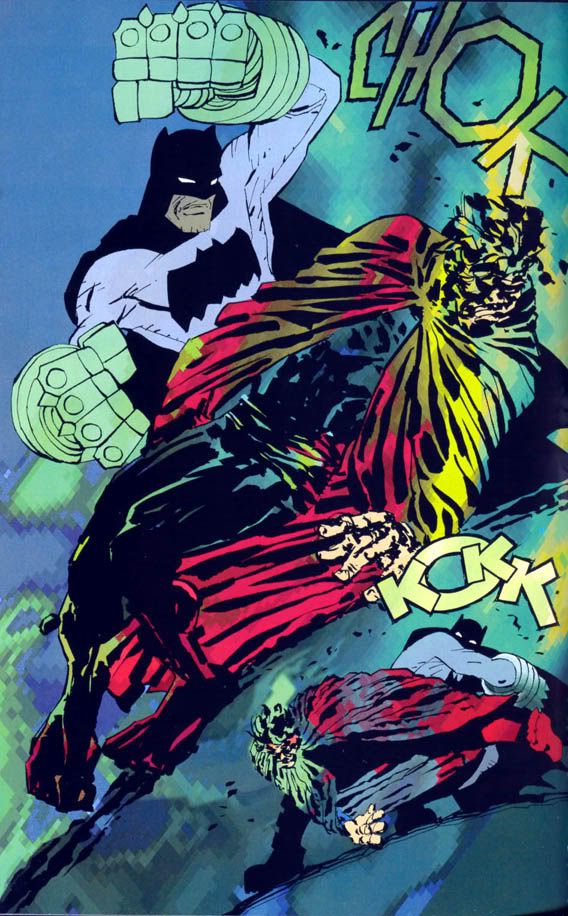 Frank Miller's sequel to his widely acclaimed The Dark Knight Returns is not thought of with much respect or affection by most comic fans. Fans expecting another DKR, a second gritty look at a tough, grizzled old Batman coming out of retirement, instead got a garish, outrageous media/government satire in which the titular Dark Knight barely even appears for long stretches of time. The book is as much Miller's snotty perspective on the DC universe in general as it is a return to his apocalyptic Batman universe, as he satirizes and pokes at the company's most iconic heroes: Superman, Wonder Woman, Green Lantern, The Question, Robin. It's probably the nastiest and ugliest work to ever come out of the Big Two's superhero factories, but there's also a kind of gaudy grandeur to Miller's vision, particularly in the computer colors of his then-partner Lynn Varley. Her work on Miller's sketchy, minimalist compositions often goes well beyond mere coloring into actually creating the Vegas-like infotainment superhighway in which this story is set. It's a messy book, no doubt about it, inflected with Miller's loony right-wing paranoia and his naked contempt for the characters he's writing about, but in spite of or maybe because of these out-there tendencies, this book is never less than a visceral, entertaining, balls-out read, from its frenzied opening to its cheekily anti-nostalgic ending. [buy]
Frank Miller's sequel to his widely acclaimed The Dark Knight Returns is not thought of with much respect or affection by most comic fans. Fans expecting another DKR, a second gritty look at a tough, grizzled old Batman coming out of retirement, instead got a garish, outrageous media/government satire in which the titular Dark Knight barely even appears for long stretches of time. The book is as much Miller's snotty perspective on the DC universe in general as it is a return to his apocalyptic Batman universe, as he satirizes and pokes at the company's most iconic heroes: Superman, Wonder Woman, Green Lantern, The Question, Robin. It's probably the nastiest and ugliest work to ever come out of the Big Two's superhero factories, but there's also a kind of gaudy grandeur to Miller's vision, particularly in the computer colors of his then-partner Lynn Varley. Her work on Miller's sketchy, minimalist compositions often goes well beyond mere coloring into actually creating the Vegas-like infotainment superhighway in which this story is set. It's a messy book, no doubt about it, inflected with Miller's loony right-wing paranoia and his naked contempt for the characters he's writing about, but in spite of or maybe because of these out-there tendencies, this book is never less than a visceral, entertaining, balls-out read, from its frenzied opening to its cheekily anti-nostalgic ending. [buy]26. THE SQUIRREL MOTHER
by Megan Kelso, 2001-2006
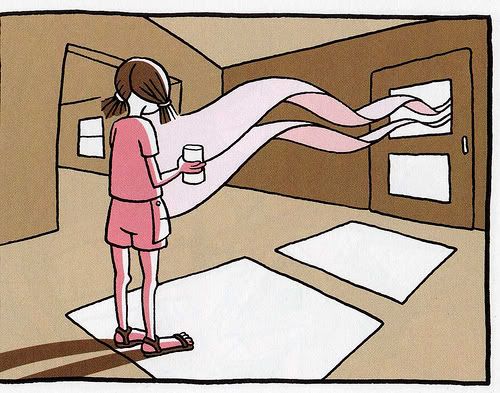 Megan Kelso's short stories are quiet and unassuming things, drawn with a clean, breezy style and unadorned dialogue. It would be easy to dimiss these fragile, open-ended pieces, collected in her anthology The Squirrel Mother, as simple and overly familiar tales of the mundane, except that Kelso's moral probing and feel for understated emotions goes far beyond the talents of most of her peers. The deceptively clean style and pastel colors suggest a light read, but Kelso's work can be devastating in the way she pares down the excess to get at the essence of a particular moment or situation, like a mother's struggle with domestic responsibility versus personal ambition in the title story. In the book's moving and mysterious final story, another woman, this one a rural pre-teen, plays a sexual game, her reasons unexplained: because there's nothing better to do, or she's insecure, or she just finds it fun? These kinds of decisions and feelings are at the core of Kelso's complex, emotionally challenging comics. [buy]
Megan Kelso's short stories are quiet and unassuming things, drawn with a clean, breezy style and unadorned dialogue. It would be easy to dimiss these fragile, open-ended pieces, collected in her anthology The Squirrel Mother, as simple and overly familiar tales of the mundane, except that Kelso's moral probing and feel for understated emotions goes far beyond the talents of most of her peers. The deceptively clean style and pastel colors suggest a light read, but Kelso's work can be devastating in the way she pares down the excess to get at the essence of a particular moment or situation, like a mother's struggle with domestic responsibility versus personal ambition in the title story. In the book's moving and mysterious final story, another woman, this one a rural pre-teen, plays a sexual game, her reasons unexplained: because there's nothing better to do, or she's insecure, or she just finds it fun? These kinds of decisions and feelings are at the core of Kelso's complex, emotionally challenging comics. [buy]25. GYO
by Junji Ito, 2001-2002
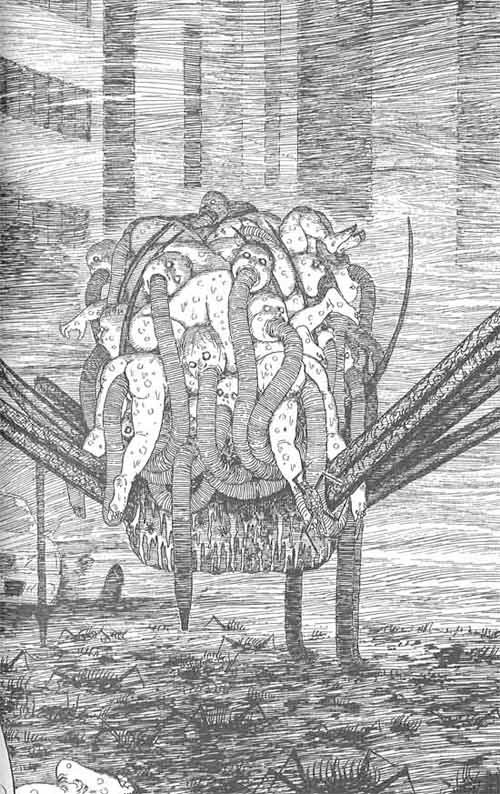 The work of horror manga-ka Junji Ito is marked by his strong, unusual imagination, his knack for concocting devilishly bizarre scenarios and extracting horror from absurdity. Nowhere is this more evident than in the two-volume Gyo, which starts from a bizarre premise — decaying fish begin to sprout robotic legs and take to the land — and just gets weirder and weirder from there. There's an element of gross-out, top-this grotesquerie to Ito's precisely drawn images, and he follows each of his nutty ideas through to its (il)logical conclusion. By the time the book ends, it's gone a long way from the jaunty disjunction of its sharks-with-legs opening premise, and the wealth of bizarre, terrifying sequences along the way make this one of modern horror comics' best works. [buy] | [buy]
The work of horror manga-ka Junji Ito is marked by his strong, unusual imagination, his knack for concocting devilishly bizarre scenarios and extracting horror from absurdity. Nowhere is this more evident than in the two-volume Gyo, which starts from a bizarre premise — decaying fish begin to sprout robotic legs and take to the land — and just gets weirder and weirder from there. There's an element of gross-out, top-this grotesquerie to Ito's precisely drawn images, and he follows each of his nutty ideas through to its (il)logical conclusion. By the time the book ends, it's gone a long way from the jaunty disjunction of its sharks-with-legs opening premise, and the wealth of bizarre, terrifying sequences along the way make this one of modern horror comics' best works. [buy] | [buy]24. MULTIFORCE
by Mat Brinkman, 2000-2005
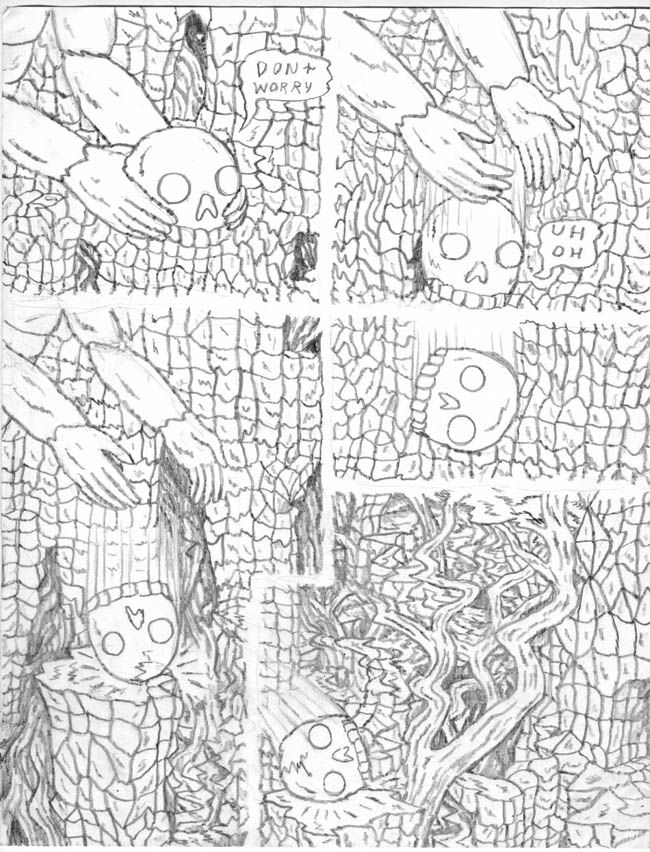 Mat Brinkman's Multiforce is quite possibly this elusive artist's defining work, consisting of a series of newspaper-format strips mostly published in the Paper Rodeo zine. These large-format single-page pieces are perfectly suited to Brinkman's feverish, incredibly detailed visions of a strange world populated by monsters, skeletons, and outlandish creatures of all kinds. His strips are funny and bizarre, packed with numerous sight gags (a skeleton head rolling down a complex series of paths, then bursting open to unleash a rainbow stream) and absurdist comic dialogue. Monsters sell arms on a street corner and the constant back-and-forth wordplay and banter make it uncertain if they mean weapons or actual limbs. A skeleton walks everywhere repeating his name as though he's terrified of losing his sense of identity, but his constant self-identification proves to be his fatal undoing. Brinkman's dense pages are filled with small stories and gags like this. He also works with radical shifts of scale, as his panels vary from tiny little clusters of miniature figures to massive landscapes that take up half a page. Multiforce is, along with Brian Chippendale's Ninja, one of the great statements to come out of the loose Fort Thunder artist's collective, an encapsulation of Brinkman's imaginative, fantastical aesthetic in a handful of large, dense pages. [buy]
Mat Brinkman's Multiforce is quite possibly this elusive artist's defining work, consisting of a series of newspaper-format strips mostly published in the Paper Rodeo zine. These large-format single-page pieces are perfectly suited to Brinkman's feverish, incredibly detailed visions of a strange world populated by monsters, skeletons, and outlandish creatures of all kinds. His strips are funny and bizarre, packed with numerous sight gags (a skeleton head rolling down a complex series of paths, then bursting open to unleash a rainbow stream) and absurdist comic dialogue. Monsters sell arms on a street corner and the constant back-and-forth wordplay and banter make it uncertain if they mean weapons or actual limbs. A skeleton walks everywhere repeating his name as though he's terrified of losing his sense of identity, but his constant self-identification proves to be his fatal undoing. Brinkman's dense pages are filled with small stories and gags like this. He also works with radical shifts of scale, as his panels vary from tiny little clusters of miniature figures to massive landscapes that take up half a page. Multiforce is, along with Brian Chippendale's Ninja, one of the great statements to come out of the loose Fort Thunder artist's collective, an encapsulation of Brinkman's imaginative, fantastical aesthetic in a handful of large, dense pages. [buy]23. GOGO MONSTER
by Taiyo Matsumoto, 2000
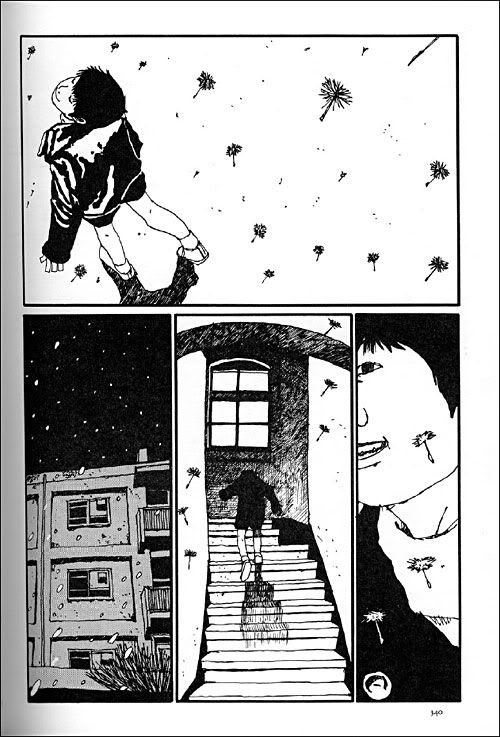 Taiyo Matsumoto, most famous for his cyberpunky magnum opus Tekkon Kinkreet, returns again to the subject of rebellious young boys in GoGo Monster. This book, originally published as a single volume in Japan in 2000 and only recently making the transition into English, is mainly focused around an outcast boy named Yuki, who is in touch with an alternate world of monsters and powerful godlike beings that only he seems to see. He shuns his peers and his ordinary world for this fantasy realm, and his gradual shift towards adulthood, when he begins to lose touch with this alternate world, is symbolized by the arrival of a new gang of more threatening, sinister monsters who begin to overwhelm and battle with Yuki's old friends. Implicit in this story is a clever metaphor for maturing, for growing up and losing touch with the vivid imagination and playfulness of childhood, which are replaced with more adult concerns about mortality and responsibility. Yuki is a boy who's afraid to grow up, and Matsumoto dramatizes and visualizes his anxiety in terms of an epic war between invisible monsters who live in water drops and dance to the sound of the boy's silver harmonica. Yuki is joined in his struggle by his new friend Makoto, a more grounded boy who is nevertheless drawn to Yuki's strange immersion in unseen worlds, and by the outcast known only as IQ, a boy so isolated from the world that he goes everywhere with a cardboard box covering his head, so that he only looks out at his surroundings through a small circular eyehole. Matsumoto's affection for these outcasts and dreamers is strong, and his own eccentric, sketchy style, so unlike most other manga, is perfectly suited to this kind of story. His ragged linework and skewed, constantly shifting perspectives contribute to the book's sense of a slippage between prosaic reality and some more magical realm whose presence is sensed in subtle ways rather than seen. [buy]
Taiyo Matsumoto, most famous for his cyberpunky magnum opus Tekkon Kinkreet, returns again to the subject of rebellious young boys in GoGo Monster. This book, originally published as a single volume in Japan in 2000 and only recently making the transition into English, is mainly focused around an outcast boy named Yuki, who is in touch with an alternate world of monsters and powerful godlike beings that only he seems to see. He shuns his peers and his ordinary world for this fantasy realm, and his gradual shift towards adulthood, when he begins to lose touch with this alternate world, is symbolized by the arrival of a new gang of more threatening, sinister monsters who begin to overwhelm and battle with Yuki's old friends. Implicit in this story is a clever metaphor for maturing, for growing up and losing touch with the vivid imagination and playfulness of childhood, which are replaced with more adult concerns about mortality and responsibility. Yuki is a boy who's afraid to grow up, and Matsumoto dramatizes and visualizes his anxiety in terms of an epic war between invisible monsters who live in water drops and dance to the sound of the boy's silver harmonica. Yuki is joined in his struggle by his new friend Makoto, a more grounded boy who is nevertheless drawn to Yuki's strange immersion in unseen worlds, and by the outcast known only as IQ, a boy so isolated from the world that he goes everywhere with a cardboard box covering his head, so that he only looks out at his surroundings through a small circular eyehole. Matsumoto's affection for these outcasts and dreamers is strong, and his own eccentric, sketchy style, so unlike most other manga, is perfectly suited to this kind of story. His ragged linework and skewed, constantly shifting perspectives contribute to the book's sense of a slippage between prosaic reality and some more magical realm whose presence is sensed in subtle ways rather than seen. [buy]22. HOW TO BE EVERYWHERE
by Warren Craghead III, 2007
 Warren Craghead's work is quite distinct from traditional comics, and this compact book — featuring Craghead's responses to the poetry of Apollinaire — is the perfect introduction to his experimental, evocative style. Craghead weaves Apollinaire's words into assemblages of minimalist drawings, most of which show fragmentary views of people and objects: an arm, a hat, a ladder, a leg, a face with no features. These fragments are arranged into complex structures on pages that use white space in striking ways. Craghead's compositions force slow, careful reading, following the unconventional flow of the words around the page, and tracing the ways in which these words — which are used as graphic elements as much as the drawings themselves — interact with the images. [buy]
Warren Craghead's work is quite distinct from traditional comics, and this compact book — featuring Craghead's responses to the poetry of Apollinaire — is the perfect introduction to his experimental, evocative style. Craghead weaves Apollinaire's words into assemblages of minimalist drawings, most of which show fragmentary views of people and objects: an arm, a hat, a ladder, a leg, a face with no features. These fragments are arranged into complex structures on pages that use white space in striking ways. Craghead's compositions force slow, careful reading, following the unconventional flow of the words around the page, and tracing the ways in which these words — which are used as graphic elements as much as the drawings themselves — interact with the images. [buy]21. OMEGA THE UNKNOWN
by Jonathan Lethem & Farel Dalrymple, 2007
 Novelist Jonathan Lethem's "cover version" of a compromised 1976-77 Steve Gerber/Mary Skrenes/Jim Mooney superhero series is a brilliant and imaginative take on superheroes made by someone who clearly loves them and sees the untapped emotional potential in the genre. Lethem's version of the story starts from the same ground as Gerber's series; his first issue is virtually a beat-for-beat remake of the original's first issue, in which a detached, intellectual young boy gets in a car accident, discovers that his parents were actually robots, and manifests strange powers after coming into contact with a blue-clad, silent superhero type, the titular Omega. From there, Lethem increasing departs from the original story, which was compromised by Marvel's insistence that Gerber incorporate multiple Marvel Universe guest stars and tell a more conventional superhero story than he'd been planning. Lethem, on the other hand, is free to explore his weirdly unlikable young hero and the resonances of the story's Hell's Kitchen setting. Lethem's typical concerns — community, race, the power of fantasy, corporate branding versus individuality — percolate throughout this story, even as it veers back and forth between a loose superhero/media satire and a nuanced coming-of-age drama. There's a lot going on here, and Dalrymple's sketchy, distinctive art, bolstered by the muted color palette of Paul Hornschemeier, breathes life into this quirky universe. Hornschemeier himself also draws a superhero origin story in one issue, but even more notable is the appearance of several jaw-dropping pages of comics-within-the-comic by the legendary Gary Panter, whose raw, energetic drawings wind up being the only self-expression of the otherwise silent alien Omega. [buy]
Novelist Jonathan Lethem's "cover version" of a compromised 1976-77 Steve Gerber/Mary Skrenes/Jim Mooney superhero series is a brilliant and imaginative take on superheroes made by someone who clearly loves them and sees the untapped emotional potential in the genre. Lethem's version of the story starts from the same ground as Gerber's series; his first issue is virtually a beat-for-beat remake of the original's first issue, in which a detached, intellectual young boy gets in a car accident, discovers that his parents were actually robots, and manifests strange powers after coming into contact with a blue-clad, silent superhero type, the titular Omega. From there, Lethem increasing departs from the original story, which was compromised by Marvel's insistence that Gerber incorporate multiple Marvel Universe guest stars and tell a more conventional superhero story than he'd been planning. Lethem, on the other hand, is free to explore his weirdly unlikable young hero and the resonances of the story's Hell's Kitchen setting. Lethem's typical concerns — community, race, the power of fantasy, corporate branding versus individuality — percolate throughout this story, even as it veers back and forth between a loose superhero/media satire and a nuanced coming-of-age drama. There's a lot going on here, and Dalrymple's sketchy, distinctive art, bolstered by the muted color palette of Paul Hornschemeier, breathes life into this quirky universe. Hornschemeier himself also draws a superhero origin story in one issue, but even more notable is the appearance of several jaw-dropping pages of comics-within-the-comic by the legendary Gary Panter, whose raw, energetic drawings wind up being the only self-expression of the otherwise silent alien Omega. [buy]

11 comments:
Hey, I actually read one of these! BLACK HOLE, to be specific. I read it when it first came out, and not since, but that sucker does linger.
Black Hole is definitely a stunner! It's undoubtedly Burns' masterpiece, though I also really like his "Big Baby" stories.
Burns also did a fantastically creepy animated short for the horror anthology Peur(s) du noir (Fear(s) of the Dark), which featured several cartoonists doing animated horror stories.
Wow, you weren't kidding when you said expect the unexpected.
-- Putting Moore on there seemed to be a given, I just didn't expect LOST GIRLS (which I was a tad bit embarrassed to own, but did flip through in a bookstore). I'm wondering if that's the last we'll see of Alan on the list?
-- Y: THE LAST MAN was indeed a fun series and probably the last great thing Vertigo launched (though FABLES is pretty fun too and I like THE LOSERS). I'm glad you pointed out the last issue which was, as you say, so perfect and unexpected a conclusion to the series.
-- Remembering ALIAS just makes me sad, as it also reminds me of when I enjoyed Bendis. It's one of the few mature themed superhero books that doesn't try to be "kewl" or simply take the piss out of the icons of the genre. Sadly, Bendis essentially destroyed Jessica's character since she was put in The Avengers. I am glad to see that they've put the series back in print, as the hardcover of it was OOP for a long time.
-- BLACK HOLE creeps me out just thinking about it. Burns does such a good job at getting that mix of teenage angst, sexual confusion, and flat out bodily horror. Can Cronenberg be in charge of making this into a movie?
-- Well, I didn't see DKSA making the list. I haven't read it since it came out, but I can still remember just how batshit crazy (no pun intended) it was. The funny thing is, it's probably much more straightforward than the full-on delusion that is ALL-STAR BATMAN AND ROBIN et al. Oh, how I wish Miller would make his Batman vs. Al-Qaeda comic...
-- MADMAN. I own all of the 90's TPB's of MADMAN, but totally forgot about this new series. Sounds like fun -- how would you compare it to the older stuff (it sounds like Allred is going in a bit of a different direction with it)?
-- Ones I have on my list to read now -- PLUTO (you mention Tezuka and my interest is piqued), OMEGA (read the first issue and never finished it up), and EPILEPTIC (that's some fantastic looking artwork by David B.)
Well three of the ones I hoped would be on your list made it in this batch (Y, ALIAS, BLACK HOLE). I still have hope that three more make your top 20 (apparently I need that to validate myself...ha).
Troy, thanks for all the comments!
- We'll just have to see about more Moore on the list, but he's definitely a favorite of mine, and Lost Girls is much more substantial and fun than its smutty origins would suggest.
- Yeah, Vertigo isn't in its prime anymore, I sample their new series every so often and Y is the only one I've really enjoyed in years. I gave up on Fables after a few books, I don't really get all the acclaim for that one.
- I almost noted myself that Bendis destroyed Jessica's character once he brought her over to the mainstream Marvel U, but decided to stick mostly to the positive. Anyway, he's really a writer who I've gotten diminishing returns from. His old crime comics are fun, Alias is brilliant, Powers is entertaining and at times more ambitious than you'd expect, but then most of his Marvel stuff just seems lazy and boring. I don't get what happened to the Bendis who could write a character like Jessica Jones.
- David Fincher has been rumored to be working on a Black Hole movie, and when I saw Burns at a Q&A a few years back he confirmed that. Who knows what will come of that, but clearly Cronenberg is THE perfect director to adapt Burns.
- Miller is nuts, but kind of entertaining nuts. I even enjoyed the hysteria and nastiness of All Star Batman and Robin, though clearly that's a whole other level of insanity.
- The new Madman series is GREAT. It's definitely a new direction for Allred. The art is a departure, an attempt to mimic the style of animation cels, and it's gorgeous. But more than that, virtually every issue engages in some grand formal experimentation; there's one issue that's basically one really long panel (a chase along a street) broken down into pages. It's such a fun series, and I'd place it up there with almost anything Allred's done before.
- You'll like those books, I think. Pluto is a great reinvention of Astro Boy, and Urasawa is probably one of the best thriller/suspense writers around. If you like that series, you might want to go in for the long haul on his earlier series Monster too, which is 20-something volumes long but well worth a read-through (or two; it's very dense and convoluted).
The strange thing about Vertigo is that they had SO many great titles go through there in the 80's and 90's that you would think they could have some original idea in the last five years. But that's a whole post in itself...
I actually enjoyed FABLES for the first 3 or 4 years, but eventually dropped it. It was kind of LoEG-lite.
I totally forgot about POWERS -- which I read the first 30 issues of and quite liked and again just makes me scratch my head at how bad most of his post-New Avengers stuff has been. I think Bendis wants too hard to be the JJ Abrams of comics, when he should be trying to be the David Chase.
A-SBAR is essential if for no other reason than to hear all the fanboy types go crazy over how Miller is ruining Batman and for the comedy material it provides bloggers.
You settled it for me, MADMAN is being bought in my next Amazon order.
I've had MONSTER on my wish list for a long time, it just sounds like such an entertaining premise. But, yeah, 20 volumes is going to be hard to commit to. I should check my library to see if they have it...
I need to read/write about comics more often. I forgot how fun it can be.
i love omega the unknown so much. i picked it up being a comics fan and a lethem fan but not sure the two would work well together. it ended up being one of the best minis i've read in years. i love Y as well. i really need to get around to reading black hole.
God, I wish I wasn't stuck in a buying-myself-things freeze at the moment, or that there was a gift-exchange-type holiday coming up. I'd be going hog wild.
I'd heard about the Fincher BLACK HOLE, and, as the news came out shortly after I saw ZODIAC, I became very excited. At this point, though, I'm not holding my breath.
Ed, regarding Burns -- I am aware of some of his other stuff (by which I mean I know it exists) such as BIG BABY and so forth, but am I correct in assuming that he's never done anything with the scope of BLACK HOLE? I definitely will get his other stuff, but BLACK HOLE makes me wish he cranked out novel-length horror comics on a yearly basis.
Troy, of course I totally forgot that 100 Bullets was also Vertigo, and obviously I loved that. But in general, yes, they do seem to have lost their way. For one thing, there's so much great stuff out there now that Vertigo doesn't stand out the way it did in, say, the early 90s. I am happy that they're FINALLY collecting Shade the Changing Man, though; one of their great and unfairly overlooked early series.
Later on in Powers there's some pretty interesting stuff going on. It's not on the level of Alias at all but it's a fun book.
Ledfloyd, totally agreed about Omega. Lethem in many is such a perfect fit as a comic writer; he obviously loves the material and has a special connection to the original Omega series. But he also brings his own very interesting literary sensibility to that series, which makes it unlike virtually anything else Marvel has published.
Bill, considering it took Burns over a decade to complete Black Hole, I'd say he's not the most prolific artist. You're right, he's done other great work, but nothing sustained like Black Hole. His other books — Big Baby, Skin Deep and El Borbah — are collections of short stories. There's some great stuff there (I especially love the creepy faux-nostalgia and 50s sci-fi pastiches of the "Big Baby" stories) but Black Hole is his single masterpiece thus far.
Of the three sections, this probably contains the most that would make my own list.
#37: I'm not actually as big a fan of this, despite my fondness for Moore (and Gebbie's underrated art). Moore's schematics pin down the proceedings in a way that undercuts the erotic release. Many brilliant bits, of course, and a devastating (but forseeable) ending, but I count it a rare miss from the creator. And Gaiman's joke about the volume's heft making it impractical as a masturbatory aid is, I think, a fair criticism given the stated point of the thing.
#36: Burns hasn't followed this up yet, has he, besides the animated short you mention? Maybe even he's intimidated by its perfection?
#34: I'm two volumes in on this, and it's shaping up to be one of my all time favorites. An absolutely compulsive page-turner, save whenever Urasawa wants you to slow down and contemplate the crisp images or the depthless emotions behind them.
#33: Brown's notes make a remarkable work in themselves (right up there with Moore's legendary annotations to From Hell), laying out how the artist's own beliefs played tug-of-war with his responsibility to portray his subject. I've never read the collected volume, just the individual issues, but have heard Brown made some considerable changes in the process. Has anybody read both to offer a comment?
#32: Still haven't picked this up, but the short stories were frequently amazing. Soon, I promise myself.
#30: You're absolutely right about David B.'s voracious spiraling out from the intimate to the universal. It makes even as admirable and clear-eyed an autobiographical work as Bechdal's Fun Home (quite wide-ranging in its own way) seem narrow.
#29: If I were compiling a list, quite possibly my number one. The full-page panel of the deathbird beneath the tree crackles with dark energy like no other illustration I've ever seen. (Partly because of the page turn, of course; amazing that Mattotti actually came up with something to match the horror on the rabbit's faces.) Mattotti's contribution to Fear(s) of the Dark was the only contribution that actually scared me. (Others, like the Burns you mention, did unnerve.)
#27: Miller's masterpiece, which becomes increasingly clear as the confused dismissals recede.
#25: One of the great portraits of a subject horror has quite the metaphorical upper hand in portraying: the fear of death closing in, and the grim inability to stop it. The back-up story "The Enigma of Amigara Fault" is, quite simply, the most terrifying comic I've ever read.
#22: Craghead has a delicacy and wistfulness in both his line and his employment of the blank page that makes his avant-gardism come off as immediate and inviting.
#21: Seeing that creative line-up makes me wonder again how this happened--and not just from one of the big two. Omega would have been a remarkable coup, and a stunning, sad, beautiful release from any publisher. Did Lethem ever clarify who Karl Rusnak was and what was his contribution (I took it for a joke, since the name reverses the villain of the piece)?
Sorry, Bill R., I did notice I'd repeated your Burns question and edited it out, but in some back-and-forth cuts and pastes it got reinstated.
Thanks again, Bruce, it's great to have your comments.
I've only read the collected Louis Riel, so I can't compare. But Brown's constant tinkering with his work is a bit aggravating. At this point, it seems he'd rather redo his old stuff than try anything new, which is a shame. I wish he'd finish up his Gospel interpretations, which were amazing. And his constant playing with Ed the Happy Clown is especially annoying since he's now decided to ignore all the later installments of the story when republishing and redoing that work. I wish he'd just let his past work stand as is and get on to creating something new again; he was once one of the greats and now seems to have dropped off the face of the earth.
I'm glad to hear some more love for DK2, and even more for Mattotti's virtually unknown little comic. Other than Huizenga's masterful series, it's the best thing to emerge from the Ignatz line, which has, in fact, yielded some pretty cool work so far.
Agreed about what a great lineup Omega had. I'm pretty sure Rusnak was just a psuedonym for Lethem, although I'm not sure why he'd do that. I may just be mis-remembering, but I don't think Rusnak's name appears on the collected edition anywhere, which would tend to confirm that.
Post a Comment